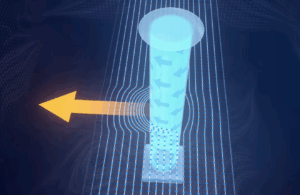How can we produce gravity in space?
Science fiction often simplifies gravity—primarily to make a less confusing environment for the audience or to fit within budget constraints. Most shows portray being on a spacecraft in the same way that we stand on Earth: with floors and ceilings, a sense of up and down. But that depiction is misleading. In reality, there is no sense of direction in space—no down, up, left, right. Additionally, there is no force of gravity to pull people one way or the other. Thus, to mimic the “gravity” that we see in television and movies, we need to create those forces ourselves. But how would that be possible? How can one create gravity? One TV show seems to have the answer: The Expanse is a long-running science fiction series that directly draws on real-life science and explores two ways that humans can create a sense of gravity in space.
One method for creating gravity is centrifugal force. The basic idea of centrifugal force is that when you spin an object, anything on the inside of that object will get pulled towards its walls (1). This force is strongest when you are at the object’s walls and has no effect when you are exactly at the object’s center. Therefore, by creating a large habitat in the shape of a cylinder, it is possible for humans to walk along the inside of its walls and feel like they are being pulled down by gravity (1, 2). In The Expanse, humanity uses this form of artificial gravity on a large scale by hollowing out the massive dwarf planet Ceres and accelerating it over the course of a decade. Once the task is completed, Ceres possesses a centrifugal force equivalent to one third of Earth’s gravity, allowing people to easily navigate around and live their lives as if they were on Earth.
The second method for creating the illusion of gravity is through linear acceleration gravity. Have you ever sat in a car while it accelerates extremely fast? The force you feel in that moment, pressing you back in your seat, is a form of linear acceleration (3). Linear acceleration gravity takes that force to the extreme. This technique involves being on a spacecraft that is accelerating constantly, for hours or days on end. You would feel similar to how you felt in the car, except that the same force that pushed you into your seat is now pushing down on your body (1, 2). Furthermore, the linear acceleration of the ship would be far greater than that of the car in order to provide a more powerful force of gravity. In The Expanse, linear acceleration gravity is far more common than centrifugal force gravity, because almost all of the show’s ships can accomplish this long-term acceleration (1). In fact, all of The Expanse’s ships are built like skyscrapers with rooms stacked on top of each other so that the gravity felt by those ships matches the direction of gravity in buildings on Earth. In real-life science, however, linear acceleration gravity is not discussed as often as centrifugal force is, because to make linear acceleration gravity a reality, we need rockets which can continuously operate for hours or days, as opposed to the mere minutes they currently can (3).
So out of these two methods, which option is best for our current world? Well, the only option we can easily accomplish right now is centrifugal force gravity, and even that requires us to overcome the engineering hurdles of hollowing asteroids or building specialized habitats. However, many decades into the future, a mix of both methods may be widespread. Centrifugal force gravity operates forever and is therefore cheap and useful for large stations. Alternatively, linear acceleration gravity allows people traveling in smaller spacecraft to still experience gravity, but is very resource-intensive. Therefore, both types of gravity would have their own particular role for our future space exploration efforts. Ultimately, it is very important for humans to have a source of gravity in outer space. Evolution has designed our minds and bodies for Earth’s gravity. Wherever we go, we cannot forget that.
Bibliography
- Allain, R. (2018, June 29). The Physics of a Spinning Spacecraft in The Expanse. WIRED. Retrieved from https://www.wired.com/story/the-physics-of-a-spinning-spacecraft-in-the-expanse/
- Feltman, R. (2013, May 3). Why Don’t We Have Artificial Gravity? Popular Mechanics. Retrieved from https://www.popularmechanics.com/space/rockets/a8965/why-dont-we-have-artificial-gravity-15425569/
- Bukley, A. et al. (2006). PHYSICS OF ARTIFICIAL GRAVITY. NASA. Retrieved from https://ntrs.nasa.gov/api/citations/20070001008/downloads/20070001008.pdf
Images
- (2024). X (Formerly Twitter). Retrieved from https://twitter.com/ToughSf/status/1759155799148920903







Comments are closed.